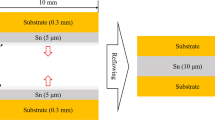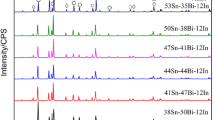Abstract
The effect of flux on the wetting characteristics of four lead-free solders, Sn-3.5Ag, Sn-0.7Cu, Sn-3.5Ag-4.8Bi, and Sn-3.8Ag-0.7Cu (wt.%), on copper substrates have been studied at 240, 260, and 280°C. The fluxes investigated were rosin (R), mildly activated rosin (RMA), and activated rosin (RA). The wetting tests were conducted using the sessile-drop method. Results showed that fluxes significantly affect the wetting properties of the solders. Contact angles ranging from 10° to 30° for RMA, 20° to 30° for RA, and 35° to 60° for R were obtained. The effect of temperature on contact angle depended on the type of flux used. The contact angle decreased with increasing temperature; however, in some cases the contact angle was independent of temperature. The Sn-3.5Ag-4.8Bi exhibited the lowest contact angles indicating improved wettability with addition of bismuth. The microstructure of the solder/copper interface was analyzed by scanning electron microscopy.
Similar content being viewed by others
References
F.W. Gayle et al., JOM 53, 17 (2001).
S.K. Kang, JOM 54, 25 (2002).
P.T. Vianco and D.R. Frear, JOM 45, 14 (1993).
C.A. MacKay, F.G. Yost, F.M. Hosking, and D.R. Frear, eds., Mechanics of Solder Alloy Wetting & Spreading (New York: Van Nostrand Reinhold, 1993), pp. 35–101.
E.P. Lopez, P.T. Vianco, and J.A. Rejent, J. Electron. Mater. 32, 254 (2003).
Z. Moser, W. Gasior, J. Pstrus, and S. Ksiezarek, J. Electron. Mater. 31, 1225 (2002).
H.K. Kim, H.K. Liou, and K.N. Tu, J. Mater. Res. 10, 497 (1995).
M.E. Loomans, S. Vaynman, G. Ghosh, and M.E. Fine, J. Electron. Mater. 23, 741 (1994).
C.W. Hwang, J.G. Lee, K. Suganuma, and H. Mori, J. Electron. Mater. 32, 52 (2003).
K.N. Tu and K. Zeng, Mater. Sci. Eng. R 34, 1 (2001).
J.H. Lau, Solder Joint Reliability (New York: Van Nostrand Reinhold, 1991), pp. 1–38.
S.P. Yu, C.L. Liao, M.H. Hon, and M.C. Wang, J. Mater. Sci. 35, 4217 (2000).
H.H. Manko, Solders and Soldering, 4th ed. (New York: McGraw-Hill, 2001).
P.T. Vianco, Soldering Handbook, 3rd ed. (Miami, FL: American Welding Society, 1999), pp. 291–310.
A. Lifton, R.A. Bulwith, and L.M. Picchione, Circuits Assembly 7, 30 (2005).
C.A. Mackay, Proc. ASM Conf., Microelectronics Packaging Technology, April, 1989, (Materials Park, OH: ASM International, 1989), p. 405.
Author information
Authors and Affiliations
Rights and permissions
About this article
Cite this article
Arenas, M.F., He, M. & Acoff, V.L. Effect of flux on the wetting characteristics of SnAg, SnCu, SnAgBi, and SnAgCu lead-free solders on copper substrates. J. Electron. Mater. 35, 1530–1536 (2006). https://doi.org/10.1007/s11664-006-0144-7
Received:
Accepted:
Issue Date:
DOI: https://doi.org/10.1007/s11664-006-0144-7




